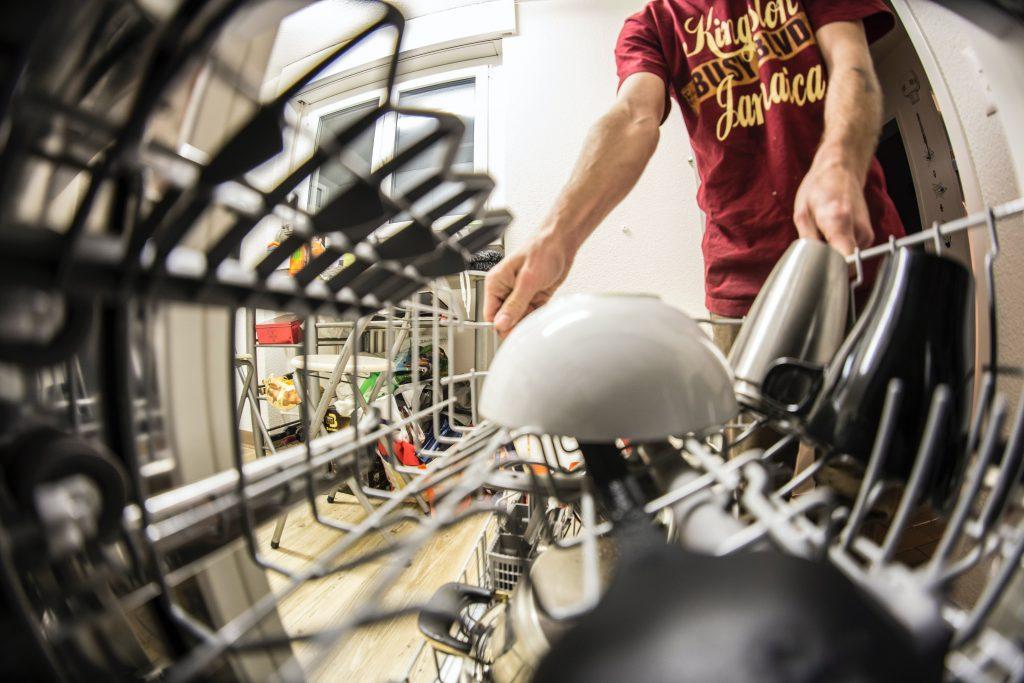How Often Should You Clean Your Dishwasher Filter?
Over time, soap scum, grease, and tiny food particles accumulate in the dishwasher filter.
Besides providing a favorable breeding environment for germs, a dirty dishwasher filter becomes less efficient. Hence, dishwasher filters need regular cleaning.
The dishwasher filter needs to be cleaned at least every 3 – 6 months.
The frequency of cleaning is dependent on how often you run your dishwasher and if you scrape or rinse your dishes before loading.
Experts recommend that you check and clean your manual filters every month.
We also advocate checking the product manual for guidance on the specific dishwasher model.
A good indicator to clean the dishwasher filter is the presence of unusual smells and sights.
Be wary of unpleasant odors, a gritty feel on dishes, or particles of food remaining behind.
Cleaning and maintaining other dishwasher parts is essential too, for it to keep performing efficiently.
Proper maintenance does not only improve the durability of your dishwasher but will ensure that it remains efficient past its average lifespan.
What Is a Dishwater Filter?
A dishwasher filter is a section that removes food debris from the wash water when the machine is in use.

During a wash cycle, the filter stops small food particles from getting re-deposited on clean dishes, or even blocking the drain.
Most of the filters are self-cleaning, but over time they get clogged by dirt and grease hence the need to be cleaned.
Older models of dishwashers (those manufactured before 2010) are mostly, fitted with self-cleaning filters.
Automatic filters come with loud grinders which make the appliances noisy when in use.
However, manufacturers have since switched to manual and more silent filters with no grinders.
The quieter filters, however, need to be manually cleaned regularly.
To find out what type of filter is in your dishwasher, check the bottom of the appliance, below its spray arms.
Self-cleaning filters come with a series of holes or a round plastic grid covering them. Filters that need manual cleaning are circular.
A dirty and blocked filter might not damage your dishwasher, but it will diminish its efficiency.
It is for this reason that regular cleaning of the dishwasher filters becomes a very necessary ritual.
You have to be sure that its heating element has cooled down before you try reaching into the appliance.
This is for your safety during the cleaning process.
Do All Dishwashers Have Filters?
Yes, all dishwashers have filters. They are either fitted with manual or automatic filters.
Dishwashers that come with automatic filters grind food debris. The fine particles will then flow away with the wastewater.
On the other hand, you have to clean manual filters by yourself.
The grinders in automatic filters are usually a tad noisy. If your dishwasher is quieter, chances are it is fitted with a manual filter.

Most automatic filters are now fitted with an ultrafine mesh but have no grinder, hence reducing the noise produced.
The water pressure pushes the food debris through the filter, crushing them into fine particles that easily wash away.
The silent type of automatic filter is mostly found in high-end dishwashers.
Alternatively, proper insulation can reduce the noise coming from an automatic filter in your dishwasher.
It is because of insulation that some dishwashers fitted with typically automatic filters might produce less noise.
What Happens If You Don’t Clean Your Dishwasher Filter?
Manual filters, which are the quietest type, need regular cleaning and maintenance.
If you don’t clean your filter, food debris that accumulates will cause unpleasant odors in the dishwasher.
The clogging might also hinder the flow of water, making your dishes not come out as clean as possible.
How Do I Clean My Dishwasher Filter?
The process is simple. Remove the filter, clean it with running water, soap, and brush and replace it when done.
When cleaning a manual dishwasher filter, turn the appliance off before you remove it.
You can then go ahead and rinse the filter under running water until all the debris is off.
The next thing to do is to wipe any gunk that might be sticking to the plastic parts of the filter.
Replace the filter only after you are sure that it is thoroughly clean.
The manual filter is a cylindrical piece, which you can easily remove and clean.
Before you begin the cleaning process, ensure you have dish soap together with a soft scrubbing material.
An old toothbrush, brush, or sponge will suffice.
Below are nine simple steps you can follow in cleaning your dishwasher filter.
- Remove the lowest rack of your dishwasher and put it aside. Find the filter located at the bottom of the appliance’s tub (a cylindrical tube that you can twist and lock into place). Some dishwasher models might come with a secondary filter, which is a flat piece found underneath the cylindrical upper one. The user manual will help you to know whether your appliance has a secondary filter or not.
- If your dishwasher has two filters, start by removing the upper, cylindrical one. You can unlock the filter by twisting it to the left, then removing it by pulling it up gently. If there is a second lower filter, lift it out.
- Using an old toothbrush or a sponge, wash the piece in warm and soapy water. The sponge and toothbrush will be handy in removing any stubborn food debris. Thoroughly rinse the filter using warm running water. Repeat the same process with the secondary filter and air-dry on a towel.
- Carefully inspect the place occupied by the filter for any food debris. A flashlight might be helpful for a proper visual inspection. Use a wet piece of cloth to remove and clean off any sticky food particles.
- Put the filter(s) back in the right location, including the lower secondary one if any. Lock the filter(s) firmly back in place.
Also read: Why Do You Use Salt in a Dishwasher?
How Do I Check My Dishwasher Filter?
All dishwashers come fitted with one or more filters, whose main task is to eliminate food debris from the wash water, in a wash cycle.
Most of them automatically clean themselves, though sometimes they become clogged by food debris or detergents and need to be manually cleaned.

To check your dishwasher filter, follow the following steps.
- Unplug the dishwasher before you start the inspection process.
- Find and dismantle the filters within the wash-arm manifold or the circulating part of the pump.
- Wash off any food particles that are stuck on the filters.
- Carefully examine the filters to find out whether they have become worn out or damaged in any way.
- If you find out that the filters have any operational problem, then it is time to consider finding a new replacement for them.
How to Replace your Dishwasher Filter
Replacing the dishwasher filter is not a complicated process.
Hence, it is something that you can easily do by yourself, using the following simple steps.

1. Find The Dishwasher Filter
The filter is, in most cases, located at the basin’s bottom, beneath the drain cap on the central part of the wash area.
On some dishwasher models, the filter will be to the side. A quick check on the owner’s manual can give you the right location.
2. Buy The Right Filter For Your Dishwasher
You need to know the exact type of filter that you require before making your purchase.
It would be helpful to take the information on your appliance model to the dishwasher store, for you to make the correct order.
3. Turn the dishwasher power off
Ensure the dishwasher’s circuit breaker is off. Putting off the power will avert any possibility of the appliance coming on when you are still working on it.
4. Take off the filter cover
Depending on the type, the top cover either just pops off or can be screwed off. Find out which type is on your appliance and remove it.
5. Take out the old dishwasher filter
The filter sits in a cup. Get hold of the cup handle and pull it straight up. The cup will come out together with the waterline and the filter.
6. Clean the filter basin
Clean any food debris around the cup basin, using a rag or sponge.
7. Replace the dishwasher filter
Place the new filter right in the cup assembly. Ensure you connect the water tube securely to the cup. Put the assemblage back in the basin and fix the cup in its place.
8. Put back the cover in place
Put the cover back in its place, by tightening it with screws or by popping its top back in its original place.
9. Switch the power on and run the appliance
Switch the dishwasher power on and run the machine through a full cycle.
The dishes should come out sparklingly clean and free of any food debris.


